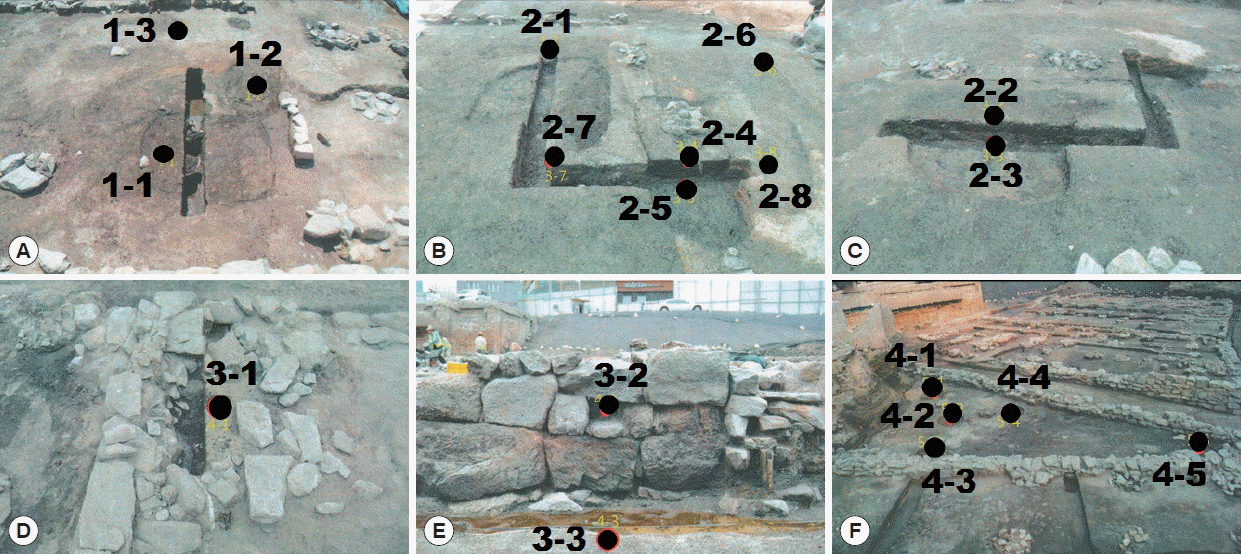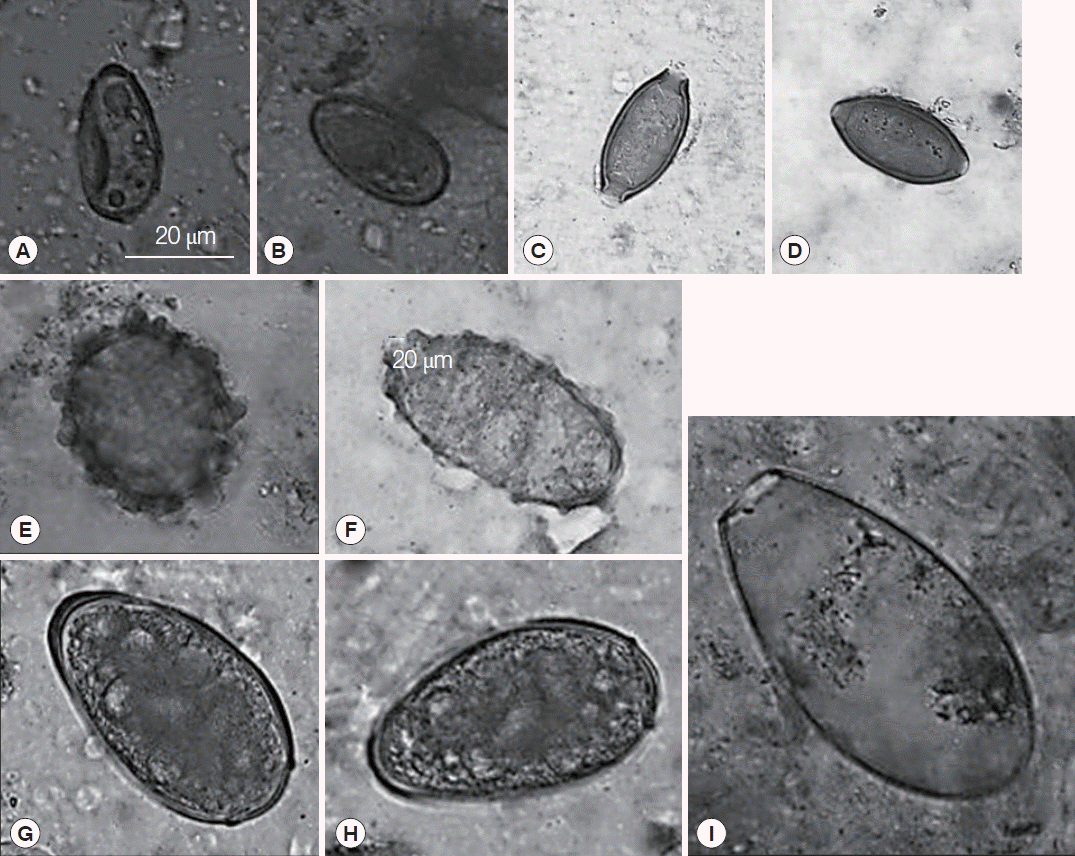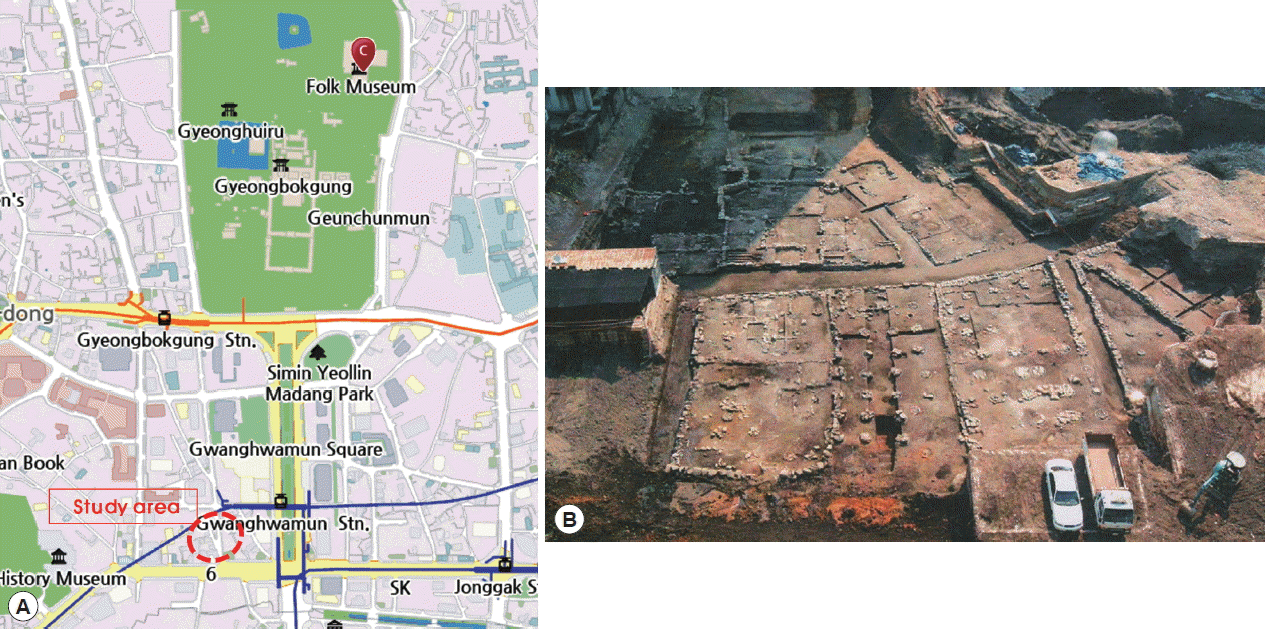Discovery of Parasite Eggs in Archeological Residence during the 15th Century in Seoul, Korea
Article information
Abstract
During civil engineering construction near Sejong-ro, Jongro-ku, Seoul, cultural sites were found that are thought to have been built in the 15th century. This area was home to many different people as well as the leaders of the Yi dynasty. To gain further insight into the life styles of the inhabitants of the old capital, soil samples were collected from various areas such as toilets, water foundations, and drainage ways. Parasite eggs were examined by microscopy after 5 g soil samples were rehydrated in 0.5% trisodium phosphate solution. A total of 662 parasite eggs from 7 species were found. Species with the highest number of eggs found were Ascaris lumbricoides (n=483), followed by Trichuris trichiura (138), Trichuris vulpis (21), Fasciola hepatica (8), Clonorchis sinensis (6), Paragonimus westermani (4), and Metagonimus yokogawai (2). These findings indirectly indicate the food habits of the people in Yi dynasty.
Paleoparasitology is the field of science that uses parasitology skills to diagnose parasitic diseases that existed in the past. Parasitological examinations of human coprolites obtained from archaeological sites are useful for determining the common parasitic infections in historical populations [1]. The first study demonstrating the presence of parasites in human remains reported the identification of Schistosoma haematobium in the renal tissues of Egyptian mummies buried between 1,250 and 1,100 BC [2]. Helminth eggs, of ancient parasites, have been discovered in various areas of Korea, including Seoul, Chungcheong-do, Gyeongsang-do, Gyeonggi-do, Jeolla-do, and Jeju-do [3–12].
Cultural heritage sites, which are thought to have been built in the 15th century during the Yi dynasty, were discovered in District 2, a developing area in the Sejong-ro area of Jongro-ku, Seoul, Korea (Fig. 1). To identify the eggs of parasites in this area, soil samples were collected from various sites, including ditches, yards, and toilets; these sites were recommended by archaeologists in 2013. The soil samples were obtained from a total of 19 sites in 4 houses, i.e., 3 locations in the 25th house, 8 locations in the 26th house, 3 locations in the 29th house, and 5 locations in the 9th house (Fig. 2). All soil samples were rehydrated in 0.5% trisodium phosphate solution for 1 week and then filtered through a simple filter apparatus [13]. The eggs were examined and photographed under a microscope at 400× magnification (Fig. 3).

Sampling sites from a 15th century medieval residential area in Seoul. The 25th house yard (A), 26th house yard (B, C), 29th house proposed toilet (D, E), and 9th house (F).

Ancient parasite eggs found in soil samples. Clonorchis sinensis (A), Metagonimus yokogawai (B), Trichuris trichiura (C, D), Ascaris lumbricoides (E, F), Paragonimus westermani (G, H), and Fasciola hepatica (I). Bar=20 μm.
A total of 662 parasite eggs from 7 species were found. Ascaris lumbricoides was found to be the most prevalent species with 438 eggs, followed by Trichuris trichiura, Trichuris vulpis, Fasciola hepatica, Clonorchis sinensis, Paragonimus westermani, and Metagonimus yokogawai.
C. sinensis eggs were measured to be 30 μm by 15 μm on average. Shoulder rims and spurs, which were in the opposite orientation as in an operculated egg, were observed. The egg surface appeared to be thick and was covered in some dust-like materials. The average length of a M. yokogawai egg was 29 μm and was measured to be 30 μm by 15 μm with a smooth and thick surface. The average length of a T. trichiura egg was 54 μm and was measured to be 45 to 50 μm by 20 to 25 μm. These eggs were well preserved and presented features common to those of modern helminth eggs. A. lumbricoides eggs retained the albumin membrane on the egg surface. They measured to be 60–70 μm×30–35 μm, and the average length was 68 μm. The length of P. westermani eggs ranged 80–100 μm×45–65 μm, and the average length was 90 μm. They showed typical shoulder rims and a thick end of the operculum. Most F. hepatica eggs had lost their operculum, and their average size was 140 μm×80 μm. The shape of T. vulpis (dog whipworm) eggs was similar to that of T. trichiura (human whipworm). However, the average length of T. vulpis was 79 μm, larger by about 25 μm than that of T. trichiura, and was measured to be 72–90 μm×32–40 μm. The mucoid plug was slightly more protruded than that of T. trichiura (Fig. 3). T. trichiura eggs typically measure 50–56 μm×21–26 μm, whereas T. vulpis eggs are almost twice as large, with dimensions of 72–89 μm×37–40 μm. T. vulpis eggs may be confused with larger helminth eggs, although they are generally wider and more barrel-shaped [14]. In addition, numerous A. lumbricoides eggs were found in the yard of the 9th house.
Interestingly, F. hepatica eggs were first found in archeological sites in Korea. F. hepatica eggs are passed through the feces of natural hosts, such as bovine, goat, and sheep, and rarely found in humans; however, they could possibly be acquired through the ingestion of raw, contaminated vegetables [15]. Fasciola spp. eggs have been reported in Viking-age archaeological sites in Denmark [16,17], the 15–17th century “Place d’Armes” in Namur, Belgium [15], and a 4,500-year-old archaeological site in Germany [18]; however, there have been no reports in Korea.
Four P. westermani and 6 C. sinensis eggs were also found in the 9th house. As C. sinensis infections can be transmitted via ingestion of raw or undercooked freshwater fish harboring the infectious metacercariae [19,20], it has been suggested that this Korean culinary tradition was practiced by pre-20th century Koreans to a greater extent than previously expected [21]. Another trematode parasite frequently detected in Joseon mummy coprolite samples is P. westermani [4,7,9,22,23]. Detection of numerous P. westermani eggs indicates that this infection was common in the Joseon people. Infected individuals may have ingested raw or incompletely cooked crabs or crayfish, since freshwater crustaceans are the second intermediate hosts of Paragonimus spp. Two M. yokogawai eggs (9th house) were detected in this study, as well as in a 16th century Joseon mummy [23], suggesting that this parasite was prevalent in the early Yi dynasty. Infection with M. yokogawai occurs due to ingestion of raw sweetfish, Plecoglossus altivelis, and is prevalent in riverside areas, in accordance with the distribution of snail and fish intermediate hosts [24,25]. Sweetfish are usually caught in restricted areas classified as the 1st grade fresh water area. Although the Han river is not currently considered a 1st grade fresh water owing to contamination with environmental waste, it is easy to imagine that the water in Han river was clean enough to catch sweetfish during Yi dynasty in the 15th century. Therefore, the daily life of civilians in Seoul might have included eating raw sweetfish caught in the Han River.
Finding many A. lumbricoides eggs in the yard is indicative of contamination with parasite eggs, which may have been caused by overflowing from a flooded toilet or other sources (Table 1). Additionally, T. vulpis eggs were found in 3 of the 4 houses tested, suggesting that most houses in Seoul reared dogs in the yard. A. lumbricoides eggs were identified in 3 houses, indicating that, during the Yi dynasty, this was an agricultural area where human feces were commonly used as fertilizer. In other words, the presence of eggs from Ascaris spp. and Trichuris spp. indicate fecal-oral infection by human and/or animal excrements [15].
Another paleoparasitological study of archaeological sites from old Seoul found heavy contamination by ancient Trichuris, Ascaris, Clonorchis, and Diphyllobothrium eggs that originated from the Royal Arsenal ruins, the Yukjo (main) street, the royal palace wall, streambed, alley, and alley-gutter [26]. However, they did not detect P. westermani, M. yokogawai, and F. hepatica eggs.
In conclusion, analysis of parasite eggs from cultural heritage sites will help in reconstructing the history of pre-modern parasitic infections. Based on our results, parasitic diseases were prevalent in old Seoul during the Yi dynasty because of the high population density, over 200,000 civilians, and floods during rainy season that exacerbated the inefficient sanitary system in old Seoul [26,27].
ACKNOWLEDGMENT
This research was supported by the Inha University Research Fund.
Notes
CONFLICT OF INTEREST
The authors declare that they have no conflicts of interest related to this work.

